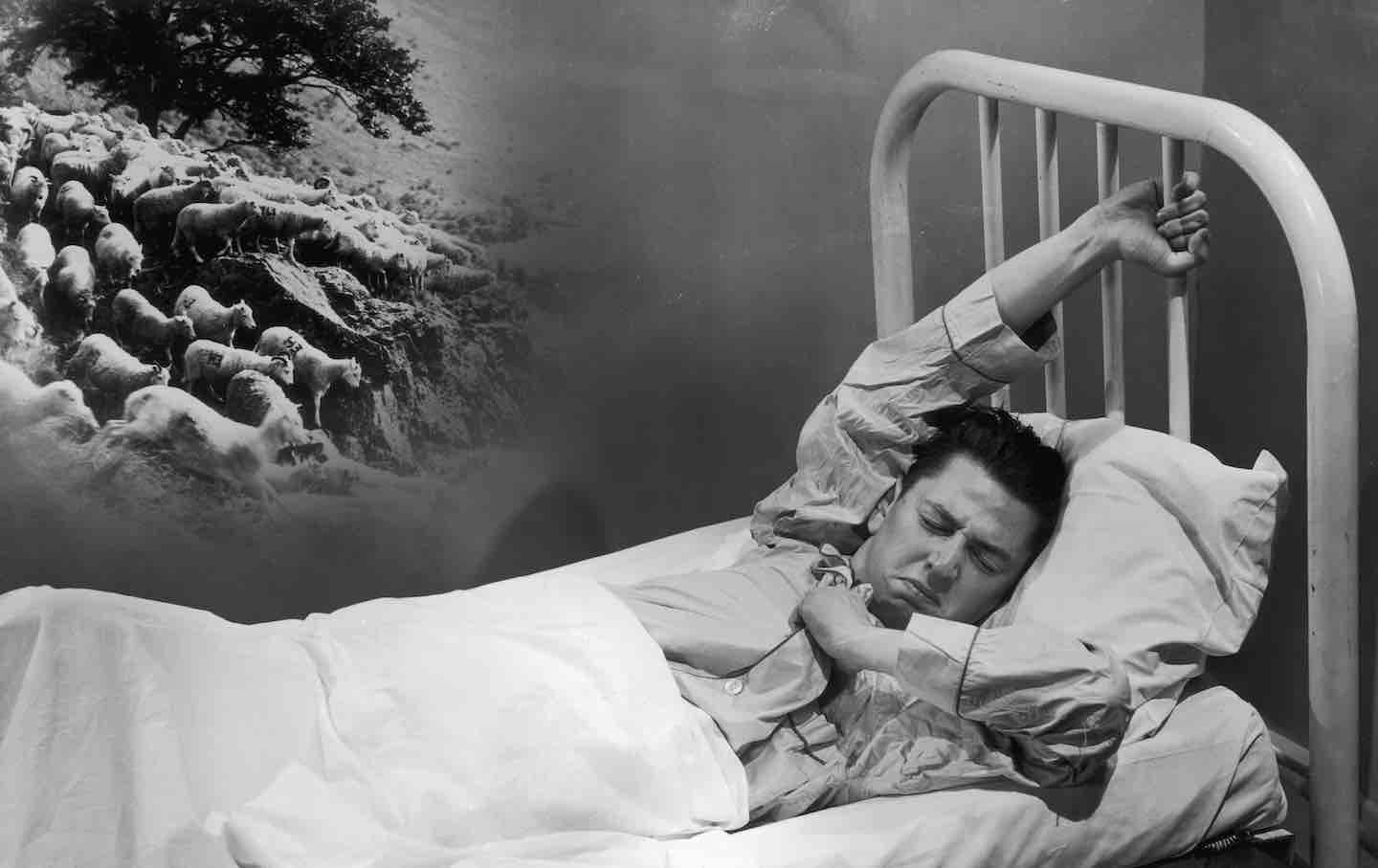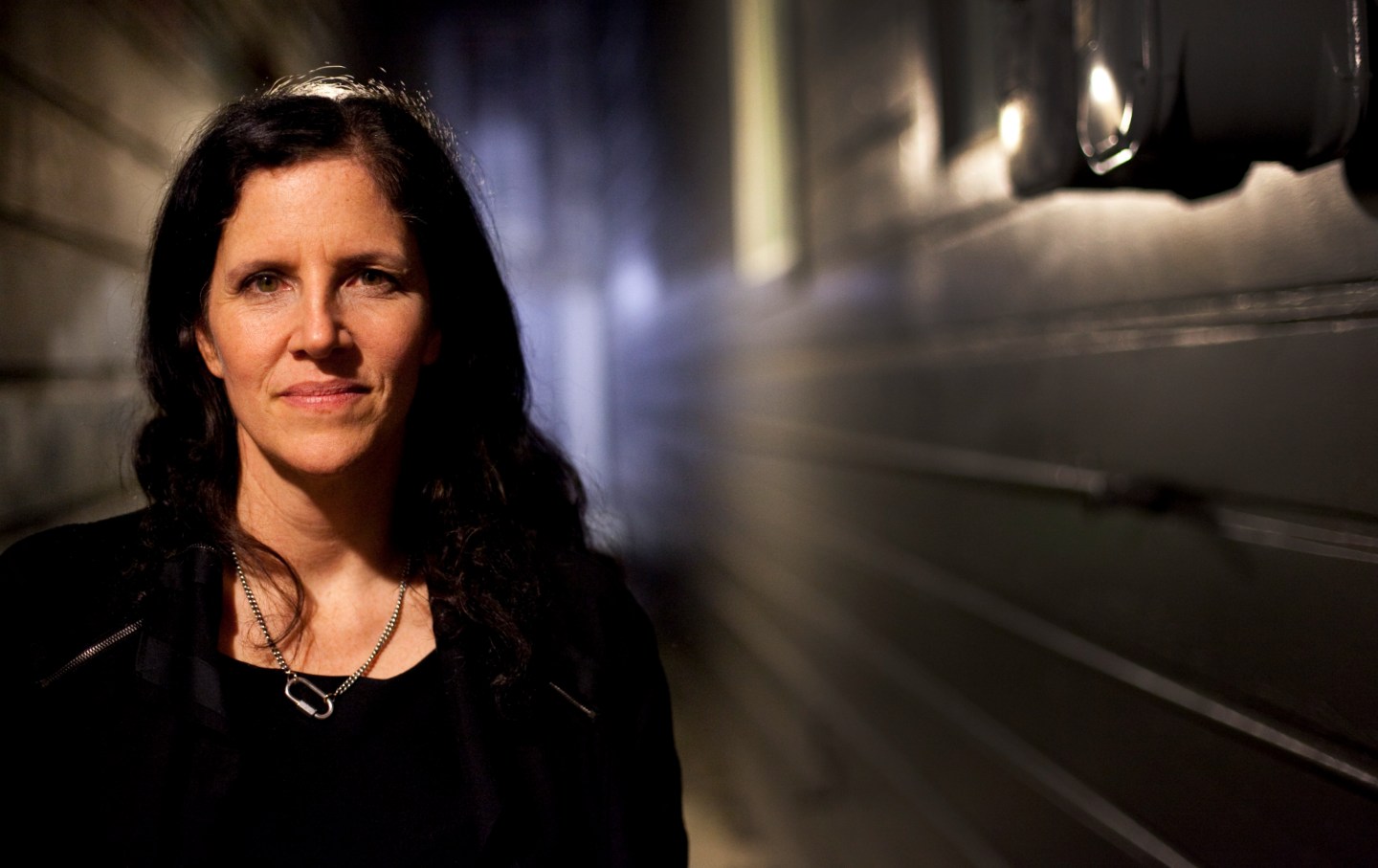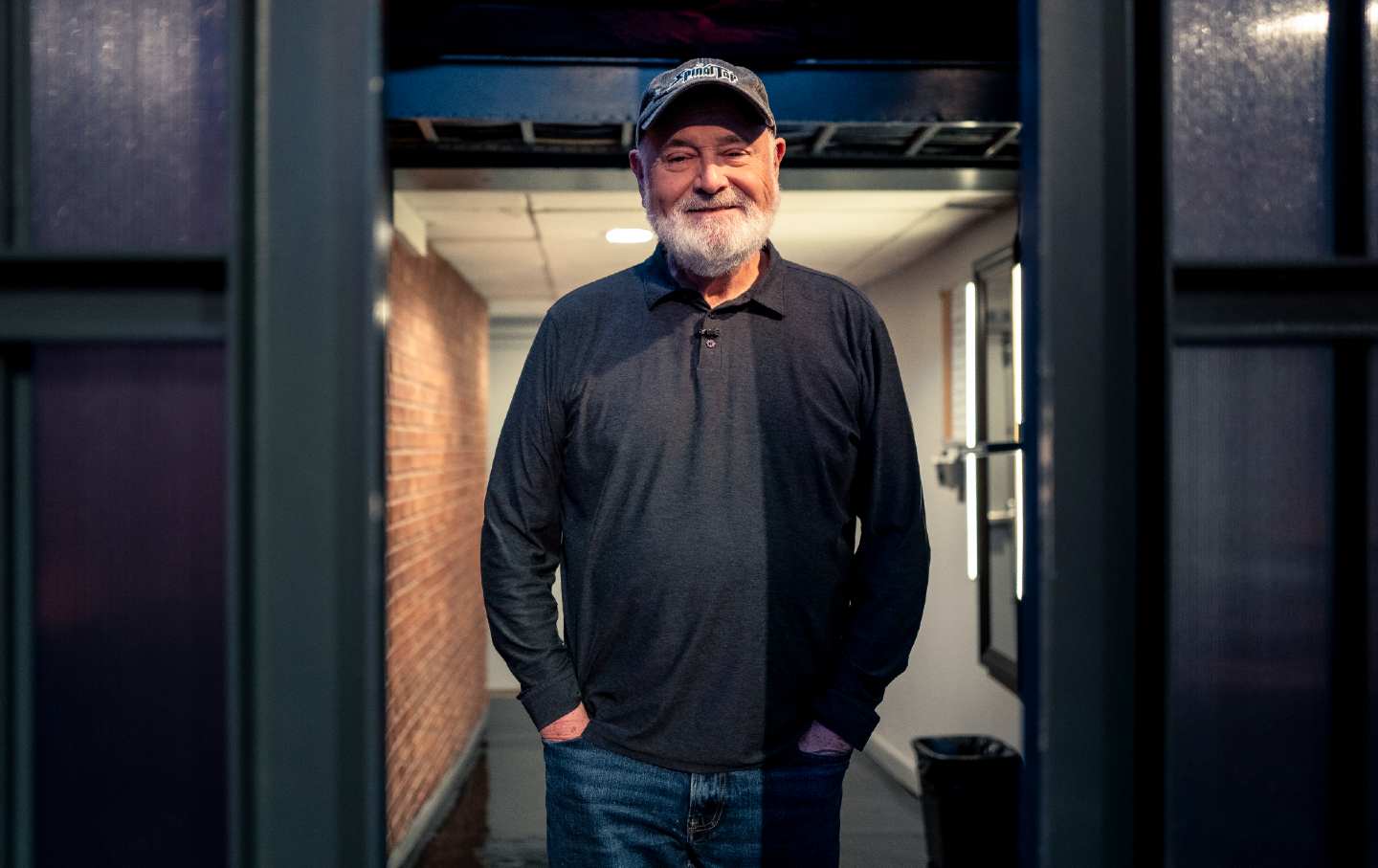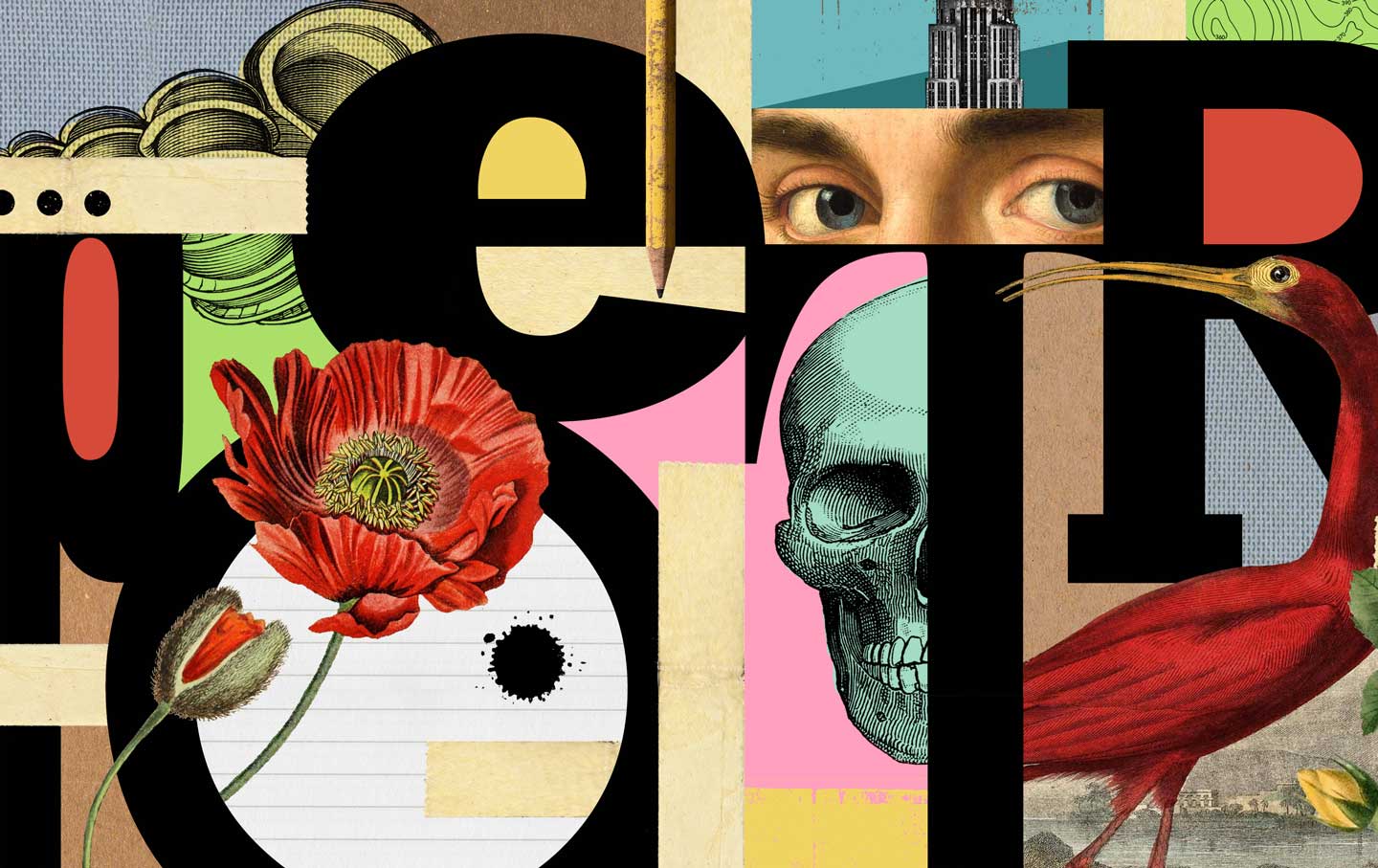A Dispatch From the Land of the “Sleepless”
A French writer’s memoir of her insomnia tries to understand how central sleep is to cultural and intellectual history.

Circa 1940, A man fights a losing battle with insomnia by counting sheep.
(Photo by FPG / Getty Images)Marie Darrieussecq hasn’t had a good night’s sleep for 20 years. In Sleepless: A Memoir of Insomnia, the French writer, psychoanalyst, and translator deconstructs the experience of those unending, insomniac “dead hours,” which she spends pacing, reading the work of other insomniacs, and performing nightly rituals—composing long lists of old babysitters, drinking glasses of chocolate soymilk in pretty cups, assuming Alexander technique poses—that she hopes might bring on sleep, but always fail to.
Books in review
Sleepless: A Memoir of Insomnia
Buy this bookSleepless is categorized as a memoir, but it reads more like a commonplace book—a collage of quotes from other artists who have written about their insomnia. Darrieussecq communes with them, the authors of what she calls “four-in-the-morning literature,” because the rest of the world is asleep—and even when the sleepers are awake, they’re unable to commiserate. Proust didn’t sleep, and neither did Perec; Duras was self-righteous about her inability to sleep; and Jean Rhys was an “inveterate insomniac.” The list is long and heady; one might begin to believe that sleeplessness marks a kind of intellectual superiority. Darrieussecq doesn’t dissuade her readers from the notion: Geniuses seem to be punished with this affliction.
Darrieussecq situates sleeplessness as a sort of paradoxical state of being. “When it comes to sleep we are not equal,” she notes, but sleeplessness is also the great equalizer: “real insomnia does not care in the slightest about objective causes, and it crosses all social classes.” She plays with this opposition frequently. Early on in Sleepless, a hierarchy of insomniacs is established alongside a moralizing binary of sleepers and non-sleepers. “The world is divided into those who sleep and those who can’t,” the book begins. Within the world of non-sleepers, there are two kinds of insomniac: those who experience occasional bouts of sleeplessness, in which “life’s worries continue through the night,” and those who are cursed with a metaphysical sleeplessness without reason. One group has earned its stripes more than the other. Darrieussecq asserts this binary gently, but she includes lines from many other thinkers who were keen to take sides.
Darrieussecq is a romantic—suggesting that insomnia, like writing, rests on a fantasy of the chosen—but she is also pragmatic, well aware that her pose of superiority is little more than a last refuge for the insomniac, a kind of fallow hopefulness carrying one through those dead hours.
Indeed, her memoir hopes to elucidate how sleep is core to every aspect of our culture, approaching it intellectually as well as at the terranean level. However, at times the book seems determined to assert a secondary project: the argument that an obsessive study of sleep is in itself an armor against sleeplessness, or at least leads one on the path to overcoming it.
Darrieussecq collates the ephemera of sleeplessness like an archivist or a detective. She is fueled by the quest to gain a deeper sociocultural understanding of sleep as well as the desire to understand her own sleeplessness as a consequence of something larger. She covers tremendous ground, weaving facts, personal narrative, photos, movie references, excerpts from newspapers, diaries, and novels. The book itself is a kind of scrapbook charting her path toward sleep, which it’s never fully certain that she finds.
In a section about beds and bedrooms, Darrieussecq writes about becoming a psychoanalyst in order to cure her own clinophilia (the urge to lay in bed for hours without sleeping), and to understand the Western obsession with excess and bric-a-brac as well as the proper feng shui of bedrooms. Along the way, there are interesting tidbits like this one: Beds are the only piece of furniture the police cannot seize. Another chapter seeks to understand the animal world through a nonhuman understanding of sleep, her dog’s third eyelid, and how a peaceful communing with animals might be one route to curing insomnia. Darrieussecq also dedicates several chapters to her time in Rwanda and Kinshasa (where she went to record the stories of genocide survivors), writing about how travel impacts her, an arduous journey through a dense forest, the connections between trauma and sleep, and the insomnia of the unhoused.
At times, Sleepless feels bursting at the seams and runs the risk of incongruity. Yet there is a kind of precision in Darrieussecq’s process: laying out everything she can gather on the topic of sleep, turning the subject a few degrees at a time, composing new arrangements of her fragments, courting new understandings.
Occasional bouts of insomnia turn into a lifetime of relentless sleeplessness for Darrieussecq. Sleep, or the lack thereof, becomes an obsession fueled by the dread of exhaustion that defines each morning. Her obsession becomes a project, and she turns her attention to the causes, implications, and consequences of her state of being, her condition. As one does when obsessed, she picks her insomnia apart, rooting it, intellectualizing it, recategorizing it, attempting to control it—but the obsession itself is an energy that reinforces her inability to sleep.
The average sleeper is likely to suggest a host of antidotes to the non-sleeper: less screen time, early-morning exercise, mindfulness, and bland foods. But these suggestions are often pointless; the insomniac has already tried everything.
Darrieussecq catalogs the various remedies she’s tried: hypnosis, psychoanalysis, herbal teas, light sadomasochism, several drugs, scholarship, various apps, sleeping with her legs elevated, masturbation, and cranial osteopathy—all with little or no result. Drinking seemed to help, or at least kept her placated as the mounting anxiety over another night spent awake loomed ever closer.
In a section titled “Overdoses,” she asks: “How many celebrities have ended up dead in the hope of sleeping?” What follows is an index of the famous people who have overdosed from some concoction containing sleeping pills: Michael Jackson, Prince, Judy Garland, Heath Ledger, Anna Nicole Smith. Whether sleeplessness was the cause of their troubles or simply a side effect is less important than what sleep offers to the suffering: a momentary shutting-out of the world and one’s own anguish. If sleep offers refuge and pills offer sleep, then it’s easy to mistake the pills themselves for salvation, understandable that one might take as many as one needs to capture a little bit of blissful oblivion.
“I’m living in a sort of death, punctuated by brief awakenings,” Proust said. He survived two overdoses; neither was a death wish (he believed suicide to be “inelegant”), but rather an attempt to induce sleep. Desperation brought him to the edge. During intractable periods of insomnia, it seems as though only death might bring some release. Or as Marguerite Duras put it: “During serious bouts of insomnia, one says to oneself, ‘If I died this instant, what a relief that would be.’”
Sleep is nonnegotiable, a vital function—one of the only vital functions, Darrieussecq notes, that has not been (fully) expropriated by capitalism. In this sense, sleep is at the center of what it means to be human. In order to live well, one must remove oneself from consciousness nightly. It is ironic, then, that in their inability to sleep, insomniacs gain whole days, even weeks each year that others spend asleep. Arguably, they are more alive, but it’s no way to live.
To sleep is to abandon control, to go beyond control completely. Herd animals are capable of falling into REM immediately, sleeping 10 to 15 minutes at a time, totaling only three to four hours a day—any longer and they would be sitting ducks for predators. Near the end of the book, Darrieussecq sees a somnologist, who gives her the diagnosis of “hypervigilance,” a “wakefulness disorder” that she thinks might as well be called a “life disorder,” as her fear is rooted in the anxiety of ceasing to have control. Perhaps this is why sleep comes more easily for her on airplanes or in hotels, where she enjoys a period of extraction, a brief sense of leaving her normal life.
I used to sleep easily, heavily, almost immediately, as though it were my job in this lifetime to sleep off an inherited exhaustion. It wasn’t until I experienced a violent home invasion that I began to have a complicated relationship with sleep. In the wake of the break-in, I lost all sense of safety. Suddenly, it felt not only possible, but probable, that it would happen again. Sleep rendered me helpless, so my body stopped allowing it. All day I prepared anxiously for a bedtime that would not come. I meditated, took supplements that promised to curb my anxiety, drank, and finally tried sleeping pills. The drug-induced rest would last only a few hours before I woke up again, wracked with anxiety and unable to fall back under.
For over a year, I only half-slept. Each creak in my old house stirred my memory, and panic shot through me. I was of a very strange mind during these hours—cynical, prone to conspiracy. I learned quickly how little fortitude I had for sleeplessness; I was a reluctant fellow traveler. How twisted my mind could become during the alien hours past midnight but before dawn, full of fear. I began to dread sleep early in the day, began to dread the next nightfall sometimes before the sun had even risen.
Popular
“swipe left below to view more authors”Swipe →After a few years, sleep returned. Perhaps it’s a kind of perverse respect that draws me to insomniacs, the safety that I project onto their alertness. I’ve always found it profoundly comforting to sleep next to someone who lies awake. I dream of a night warden or a bodyguard. Darrieussecq echoes this: “hitchhiking…with the man I love…. O.R. was an insomniac. I could rely on him to stay awake and keep an eye on things. The longer he stayed awake, the better I slept.”
“It’s all very well knowing it—we scarcely sleep any better,” Darrieussecq writes early on in Sleepless. Unlike most memoirs, the book was written with an agenda: By the end of the writing process, she hopes she will sleep through the night. If there is a redemptive arc to this story, it takes the form of submission and is only realized when Darrieussecq is able to accept her sleeplessness rather than rail against it. It is not that insomnia is larger than her; rather, it is integral to her experience of the world. Finally, she gives herself over, becoming a supplicant to the dead hours in the hope that she might seek peace within them.
Disobey authoritarians, support The Nation
Over the past year you’ve read Nation writers like Elie Mystal, Kaveh Akbar, John Nichols, Joan Walsh, Bryce Covert, Dave Zirin, Jeet Heer, Michael T. Klare, Katha Pollitt, Amy Littlefield, Gregg Gonsalves, and Sasha Abramsky take on the Trump family’s corruption, set the record straight about Robert F. Kennedy Jr.’s catastrophic Make America Healthy Again movement, survey the fallout and human cost of the DOGE wrecking ball, anticipate the Supreme Court’s dangerous antidemocratic rulings, and amplify successful tactics of resistance on the streets and in Congress.
We publish these stories because when members of our communities are being abducted, household debt is climbing, and AI data centers are causing water and electricity shortages, we have a duty as journalists to do all we can to inform the public.
In 2026, our aim is to do more than ever before—but we need your support to make that happen.
Through December 31, a generous donor will match all donations up to $75,000. That means that your contribution will be doubled, dollar for dollar. If we hit the full match, we’ll be starting 2026 with $150,000 to invest in the stories that impact real people’s lives—the kinds of stories that billionaire-owned, corporate-backed outlets aren’t covering.
With your support, our team will publish major stories that the president and his allies won’t want you to read. We’ll cover the emerging military-tech industrial complex and matters of war, peace, and surveillance, as well as the affordability crisis, hunger, housing, healthcare, the environment, attacks on reproductive rights, and much more. At the same time, we’ll imagine alternatives to Trumpian rule and uplift efforts to create a better world, here and now.
While your gift has twice the impact, I’m asking you to support The Nation with a donation today. You’ll empower the journalists, editors, and fact-checkers best equipped to hold this authoritarian administration to account.
I hope you won’t miss this moment—donate to The Nation today.
Onward,
Katrina vanden Heuvel
Editor and publisher, The Nation
More from The Nation

Why “The Voice of Hind Rajab” Will Break Your Heart Why “The Voice of Hind Rajab” Will Break Your Heart
A film dramatizing a rescue crew’s attempts to save the 5-year-old Gazan girl might be one of the most affecting movies of the year.

How Laura Poitras Finds the Truth How Laura Poitras Finds the Truth
The director has a knack for getting people to tell her things they've never told anyone else—including her latest subject, Seymour Hersh.

Rob Reiner’s Legacy Can't Be Sullied by Trump’s Shameful Attacks Rob Reiner’s Legacy Can't Be Sullied by Trump’s Shameful Attacks
The late actor and director leaves behind a roster of classic films—and a much safer and juster California.

Blood Orange’s Sonic Experiments Blood Orange’s Sonic Experiments
Dev Hynes moves between grief and joy in Essex Honey, his most personal album yet.



